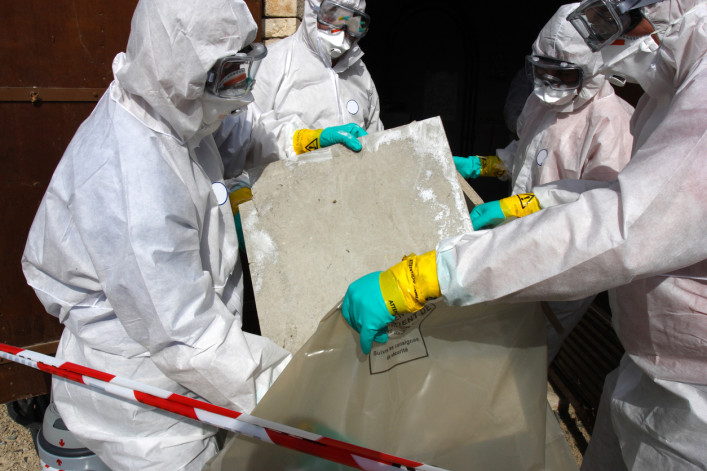Asbestos 101: Everything you need to know

Asbestos is a carcinogen that causes problems if it becomes airborne.
iStock
When most of us think of asbestos, it's as a retro bogeyman along the lines of lead paint—something you generally know to be bad (even if the details are fuzzy), but doesn't wake you up in a cold sweat. So what exactly is the deal? We consulted the experts to separate fact from fiction, and to find out exactly how worried we should be (and how much an asbestos problem will cost to fix).
What is asbestos?
Asbestos is a mineral that was frequently used as flame-retardant insulation until it was discovered to be a human carcinogen in the 1970s. As such, it's most commonly found in post-war buildings that went up in the 1950s and 1960s. (It's particularly known for causing mesothelioma.) But its mere presence in your building isn't likely to spell doom. Disturbing it is.
"Asbestos doesn't pose a health problem unless it becomes damage or crumbled, that's when it becomes airborne," explains Jenvy Ames, an estimator with J&J Asbestos Abatement. "If it's in good shape, leave it alone. When you're renovating is when you need to worry about it."
As such, Ames recommends testing floors and ceilings before starting work. "You can hire a laboratory to come in and take samples," he says. "But there are also companies around New York that let you put a small piece of material [e.g. a piece of drywall] in a Ziploc bag, take it in, and they'll analyze it for around $20 or $50, depending on the material." Plus, when you file with the city for renovations, you're required to disclose whether or not asbestos is present, says Cynthia Graffeo, director of client relations at property manager Argo Real Estate. "If it is, you'll be required to have it abated in accordance with NYC code," she says.
To that end, Ames also recommends insisting on having an apartment tested before you buy. Sellers aren't required to tell you that there's asbestos-containing material in the apartment, says real estate attorney Dean Roberts of Norris, McLaughlin & Marcus, so the onus is on you to figure it out.
That said, if you do find yourself facing down an asbestos issue (or a pricey abatement), Roberts notes, "The protocols have gotten pretty straightforward, and there's a whole sub-industry set up to deal with it. It's much less of an issue than it used to be [10 or 20 years ago]."
Where do you find it?
Since asbestos' primary function is as insulation, you're most likely to encounter it in heating systems, Ames tells us, on the boiler or behind walls wrapped around pipes. It's also been used as soundproofing insulation between apartments, in ceiling and wall plaster, and in certain types of linoleum and kitchen tiles (usually ones that measure 9 by 9 inches).
It can also show up in common areas of a building, as pipe wrapping in boiler rooms or insulation for "risers" that transport hot water throughout the building, Graffeo notes.
How much does it cost to fix?
The cost of your abatement will depend on the size and scope of the problem. For instance, Ames says, if you're looking to abate kitchen tiles that contain asbestos, the costs could range between $4 per square foot and $8 per square foot, depending on if the glue used on the tiles also contains asbestos (which makes the removal process much trickier). If you're doing a major renovation—say, combining two neighboring apartments you've purchased—and have to knock down walls that have thick asbestos sound insulation (again, a problem most frequently seen in post-wars), Ames says the work can cost around $30 per square foot.
One potential upside: if your abatement is part of a larger claim that's covered by your apartment insurance—for example, repairing a ceiling that's collapsed from water damage and contains asbestos—your policy should also cover the cost of removal and remediation, says Jeff Schneider, president of insurance firm Gotham Brokerage. But this is only true if the work is a necessary part of another covered claim.
There also a good chance your building might end up covering the cost. "Most of the time when there is asbestos, it tends to be a building financial responsibility," says Graffeo. "It's somewhat rare in this day and age that it's a shareholder or unit owner responsibility."
"[The billing] depends on the nuances of your contract," adds Roberts. "Sometimes the occupancy agreements will say the floor is the co-op's responsibility, in which case it's the co-op that pays."
So how should my building handle it?
Oftentimes, older buildings will take the preemptive measure of requiring owners to abate any asbestos before selling, says Roberts, in order to seize the opportunity to fix the problem before a new owner moves in.
Additionally, your management company should help coordinate with you and your contractor to ensure that the work is done up to code and make the abatement process as easy as possible, says Graffeo. And if it's the building doing an asbestos abatement, they're required to send out a notification to all residents listing the work date (or dates), and clearly stating that the abatement will be done in conformance with New York City code. The same goes for renters: while the landlord isn't obligated to disclose the presence of asbestos, if they're doing an abatement, they're required to notify you, cover the costs, and follow city protocol to keep you safe.
Related:
Is your apartment making you sick? 3 places to look for mold
A quick primer on when—and when not—to DIY
Could your floors be making you sick? How to find out and what you can do
How to pay for your renovation with a home equity line of credit (sponsored)






















